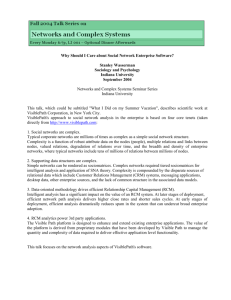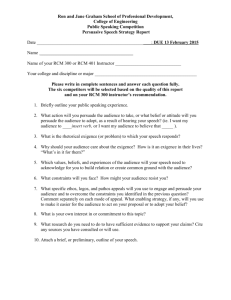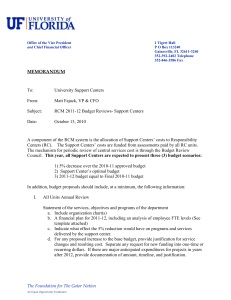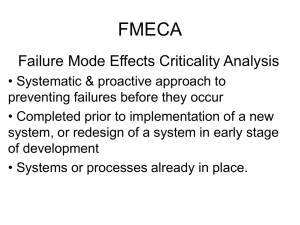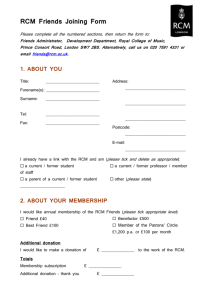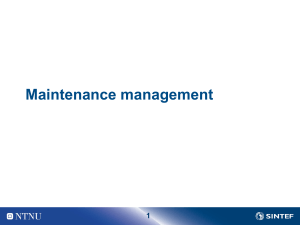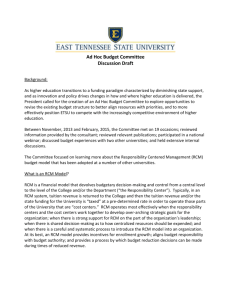IEC 61508 - NO
advertisement
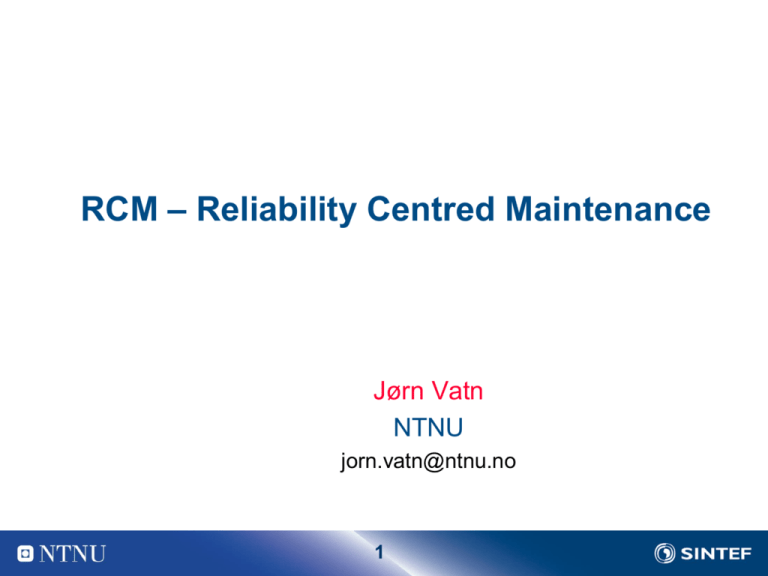
RCM – Reliability Centred Maintenance Jørn Vatn NTNU jorn.vatn@ntnu.no 1 What is RCM? RCM is a method for maintenance planning developed in the sixties within the aircraft industry and later adapted to several other industries and military branches A major advantage of the RCM analysis process is a structured, and traceable approach to determine the optimal type of preventive maintenance (PM) The main focus is on preventive strategies, but the results from the analysis may also be used in relation to corrective maintenance strategies, spare part optimization, and logistic consideration 2 The seven main questions in RCM 1. What are the system functions and the associated performance standards? 2. How can the system fail to fulfill these functions? 3. What can cause a functional failure? 4. What happens when a failure occurs? 5. What might the consequence be when the failure occurs? 6. What can be done to detect and prevent the failure? 7. What should be done when a suitable preventive task cannot be found? 3 The main objectives of an RCM analysis process are to: Identify effective maintenance tasks Evaluate these tasks by some cost–benefit analysis Prepare a plan for carrying out the identified maintenance tasks at optimal intervals 4 Steps involved in an RCM analysis 1. 2. 3. 4. 5. 6. 7. 8. 9. 10. 11. 12. Study preparation System selection and definition Functional failure analysis (FFA) Critical item selection Data collection and analysis Failure modes, effects, and criticality analysis (FMECA) Selection of maintenance actions Determination of maintenance intervals Preventive maintenance comparison analysis Treatment of non–critical items Implementation In–service data collection and updating 5 RCM = Collection of techniques System: Compressor train Subsys: Compressor A FMEA Tag Number Function Operat. Mode Failure Mode Co5008 xxxx xxxx xxxxxxxx yyy yyyyy xxxxxxxx zzzzzz xxxxxxxx zzzzzzzx xxxxxxxx dddd vvvvvvv dddd xxxxxxxxxx dddddd RCM 6 Step 1: Study preparation Before the actual RCM analysis process is initiated, an RCM project group must be established The group should include at least one person from the maintenance function and one from the operations function, in addition to an RCM specialist. Define consequences to be evaluated, e.g.: Human injuries and/or fatalities Negative health effects Environmental damage Loss of system effectiveness (e.g., delays, production loss) Material loss or equipment damage Loss of marked shares 7 Step 2: System selection and definition Before a decision to perform an RCM analysis is taken, two questions should be considered: To which systems are an RCM analysis beneficial compared with more traditional maintenance planning? At what level of assembly (plant, system, subsystem) should the analysis be conducted? 8 System hierarchy Plant System A Equipment unit Pump System B .. Compressor ... Component Impeller Feilure mode A (Loss of function) ... ... Failure mechanism - Corrosion - Fatigue - "Drift", etc 9 System N RCM approach Plant System A Equipment unit Pump System B .. Compressor ... Component Impeller Feilure mode A (Loss of function) System N One system is chosen at a time Analysis item ... ... Failure mechanism - Corrosion - Fatigue - "Drift", etc Failure mechanisms and failure causes could be mitigated, i.e. maintenance 10 Step 3: Functional failure analysis (FFA) The objectives of this step are to 1. Identify and describe the systems’ required functions 2. Describe input interfaces required for the system to operate 3. Identify the ways in which the system might fail to function 11 Type of functions 1. Essential functions: These are the functions required to fulfil the intended purpose of the item. An essential function of a pump is, e.g., to pump a fluid. 2. Auxiliary functions: These are the functions that are required to support the essential functions. 1. An auxiliary function of a pump is, e.g., to “contain fluid.” 3. Protective functions: The functions intended to protect people, equipment, and the environment from damage and injury. An example of a protective function is the protection provided by a rupture disk on a pressure vessel. 4. Information functions: These functions comprise condition monitoring, various gauges and alarms, and so on. 5. Interface functions: These functions apply to the interfaces between the item in question and other items. 6. Superfluous functions: Those functions we do not need any more 12 Functional block diagram to describe relation between functions 13 Analysis of functions Each main function of the system is analysed in an FFA form: System: Ref. drawing no.: Operational mode Function Performed by: Date: Function requirements Functional failure 14 Page: of: Frequency Criticality S E A C Step 4: Critical item selection The objective of this step is to identify the analysis items that are potentially critical with respect to the functional failures identified in Step 3 These analysis items are denoted functional significant items (FSI) In addition to the FSIs, we should also identify items with high failure rate, high repair costs, low maintainability, long lead-time for spare parts, or items requiring external maintenance personnel These analysis items are denoted maintenance cost significant items (MCSI). The sum of the functional significant items and the maintenance cost significant items are denoted maintenance significant items (MSI) 15 Step 5: Data collection and analysis The purpose of this step is to establish a basis for both the qualitative analysis (relevant failure modes and failure causes), and the quantitative analysis (reliability parameters such as MTTF, PF-intervals, and so on) The data necessary for the RCM analysis may be categorized in the following three groups: 1. Design data (Equipment type, capacities etc) 2. Operational and failure data (operating # of hours, failure times etc) 3. Reliability data (MTTF, aging parameters etc) 16 Step 6: FMECA The objective of this step is to identify the dominant failure modes of the MSIs identified in Step 4 The information entered into the FMECA worksheet should be sufficient both with respect to maintenance task selection in Step 7, and interval optimization in Step 8 Our FMECA worksheet has more fields than the FMECAs found in most RCM standards The reason for this is that we use the FMECA as the main database for the RCM analysis Other RCM approaches often use a rather simple FMECA worksheet, but then have to add an additional FMECA-like worksheet with the data required for optimization of maintenance intervals 17 Top events Experience has shown that we can significantly reduce the workload of the FMECA by introducing so-called top events as a basis for the analysis The idea is that for each failure mode in the FMECA, a socalled top event is specified as consequence of the failure mode A number of failure modes will typically lead to the same top event A consequence analysis is then carried out for each top event to identify the end consequences of that particular top event, covering all consequence classes (e.g., safety, availability/punctuality, environmental aspects) 18 Barrier model for safety C1 C2 Initiating event TOP event “Red bulb failure” “Train collision” C3 C4 C5 C6 Failure cause: Maintenance barrier: Other barriers: - Burn-out bulb - Preventive replacement - Directional setting “block” - Automatic train protection - Train control centre 19 Consequence reducing barriers: - Rescue team - Train construction - Fire protection Example of TOP events, safety Train derailment Collision train-train Collision train-object Fire Persons injured or killed in or at the track Persons injured or killed at level crossings Passengers injured or killed at platforms 20 End consequence classes: C1: C2: C3: C4: C5: C6: Minor injury Medical treatment Permanent injury 1 fatality 2-10 fatalities >10 fatalities 21 Fields in the FMECA Failure mode (equipment class level). The first column in the FMECA worksheet is the failure mode at the equipment class level identified in the FFA in Step 3. Maintenance significant item (MSI). The relevant MSI were identified in the FFA. MSI function. For each MSI, the functions of the MSI related to the current equipment class failure mode are identified. Failure mode (MSI level). For the MSI functions we also identify the failure modes at the MSI level. 22 Fields in the FMECA, cont Detection method. The detection method column describes how the MSI failure mode may be detected, e.g., by visual inspection, condition monitoring, or by the central train control system (for railway applications). Hidden or evident. Specify whether the MSI function is hidden or evident. Demand rate for hidden function, fD. For MSI functions that are hidden, the rate of demand of this function should be specified. Failure cause. For each failure mode there is one or more failure causes. An failure mode will typically be caused by one or more component failures at a lower level. Note that supporting equipment to the component is considered for the first time at this step. In this context a failure cause may therefore be a failure mode of a supporting equipment. 23 Fields in the FMECA, cont Failure mechanism. For each failure cause, there is one or several failure mechanisms. Examples of failure mechanisms are fatigue, corrosion, and wear. To simplify the analysis, the columns for failure cause and failure mechanism are often merged into one column. Mean time to failure (MTTF). The MTTF when no maintenance is performed should be specified. The MTTF is specified for one component if it is a “point” object, and for a standardized distance if it is a “line” object such as rails, sleepers, and so on. top event safety. The top event in this context is the accidental event that might be the result of the failure mode. The top event is chosen from a predefined list established in the generic analysis 24 Fields in the FMECA, cont Barrier against top event safety. This field is used to list barriers that are designed to prevent a failure mode from resulting in the safety top event. For example, brands on the signalling pole would help the locomotive driver to recognize the signal in case of a dark lamp. PTE-S. This field is used to assess the probability that the other barriers against the top event all fail. PTE-S should count for all the barriers listed under “Barrier against top event safety”. top event availability/punctuality. Also for this dimension a predefined list of top events may be established in the generic analysis. Barrier against top event availability/punctuality PTE-S Other consequence 25 Fields in the FMECA, cont Mean downtime (MDT). The MDT is the time from a failure occurs until the failure has been corrected and any traffic restrictions have been removed. Criticality indexes. Based on already entered information, different criticality indexes can be calculated. These indexes are used to screen out non-significant MSIs. 26 Additional fields critical MSIs Failure progression. For each failure cause the failure progression should be described in terms of one of the following categories: (i) gradual observable failure progression, (ii) non-observable and the fast observable failure progression (PF model), (iii) non-observable failure progression but with aging effects, and (iv) shock type failures. Gradual failure information. If there is a gradual failure progression information about a what values of the measurable quantity represents a fault state. Further information about the expected time and standard deviation to reach this state should be recorded. PF-interval information. In case of observable failure progression the PF model is often applied. The PF concept assumes that a potential failure (P) can be observed some time before the failure (F) occurs. This time interval is denoted the PF interval 27 Additional fields critical MSIs, cont Aging parameter. For non-observable failure progression aging effects should be described. Relevant categories are strong, moderate or low aging effects. The aging parameter can alternatively be described by a numeric value, i.e., the shape parameter in the Weibull distribution. Maintenance task. The maintenance task is determined by the RCM logic discussed in Step 7. Maintenance interval. Often we start by describing existing maintenance interval, but after the formalized process of interval optimalization in Step 8 we enter the optimized interval. 28 FMECA example: Red light bulb Component Red light bulb, main signal Functions Give the enginge driver a signal to ”STOP” Enabling the possibility to allow green light from the other direction Failure mode No light from the light bulb Failure causes Burnt-out filament, short circuit, wire failure, lamp socket Failure effects Safety: May lead to collision train-train Punctuality: Not able to set green light from the other side, delays 29 FMECA example: Red light bulb Component Red light bulb, main signal Functions Give the enginge driver a signal to ”STOP” Enabling the possibility to allow green light from the other direction Failure mode No light from the light bulb Failure causes Burnt-out filament, short circuit, wire failure, lamp socket Failure effects Safety: May lead to collision train-train Punctuality: Not able to set green light from the other side, delays 30 Example of a part of an FMECA worksheet System function: Functional failure: Ensure correct departure light signal No signal MSI Function Failure mode Failure cause Lamp Give light No light Burntout filament Train Train Lens Protect lamp Broken lens Rock fall Slip through light No light slipping through Fouling event Safety Safety barriers event Punct. PTE-S TOP Directional block, ATP, TCC, “Black=red” 310-4 Manual train operation Train Train Directional block, ATP, TCC, “Black=red” 210-5 None Train Train Directional block, ATP, TCC, “Black=red” 210-4 None TOP 31 Step 7: Selection of Maintenance Actions A decision logic is used to guide the analyst through a question–and–answer process The input to the RCM decision logic is the dominant failure modes from the FMECA in Step 6 The main idea is for each dominant failure mode to decide whether a preventive maintenance task is suitable, or it will be best to let the item deliberately run to failure and afterwards carry out a corrective maintenance task 32 Type of maintenance tasks The failure mechanisms behind each of the dominant failure modes should be entered into the RCM decision logic to decide which of the following basic maintenance tasks that is most applicable: Continuous on–condition task (CCT) Scheduled on–condition task (SCT) Scheduled overhaul (SOH) Scheduled replacement (SRP) Scheduled function test (SFT) Run to failure (RTF) 33 Maintenance Task Assignment/Decision logic Yes Does a failure alerting measurable indicator exist? Yes Is continuous monitoring feasible? No No Yes Is aging parameter >1? Yes Is overhaul feasible? No No Is the function hidden? Yes Continuous oncondition task (CCT) Scheduled oncondition task (SCT) Scheduled overhaul (SOH) Scheduled replacement (SRP) Scheduled function test (SFT) No No PM activity found (RTF) 34 Red light bulb example Yes Does a failure alerting measurable indicator exist? Yes Is continuous monitoring feasible? No No Yes Is aging parameter >1? Yes Is overhaul feasible? No No Is the function hidden? Yes Continuous oncondition task (CCT) Scheduled oncondition task (SCT) Scheduled overhaul (SOH) Scheduled replacement (SRP) Scheduled function test (SFT) No No PM activity found (RTF) 35 Matrix light bulb Yes Does a failure alerting measurable indicator exist? Yes Is continuous monitoring feasible? No No Yes Is aging parameter >1? Yes Is overhaul feasible? No No Is the function hidden? Yes Continuous oncondition task (CCT) Scheduled oncondition task (SCT) Scheduled overhaul (SOH) Scheduled replacement (SRP) Scheduled function test (SFT) No No PM activity found (RTF) 36 Step 8: Determination of Maintenance Intervals There exist optimization models we may apply to obtain the optimal maintenance interval Required information The failure model for the component, e.g., a Weibull model The cost of preventive and corrective maintenance cost per maintenance task PTE-S, and PTE-P, i.e., the probability that a component failure gives the TOP event for safety and punctuality (or availability) The expected safety and punctuality cost, given that the TOP events occur 37 Example, interval optimization Cost per year PLL-Cost Mat.-Cost Punct.-Cost PM-Cost CM-Cost Tot-Cost 14 12 10 8 6 4 2 0 1.0 1.5 2.0 2.5 3.0 3.5 Interval (years) 38 4.0 4.5 5.0 Step 9: Preventive maintenance comparison analysis Two overriding criteria for selecting maintenance tasks are used in RCM. Each task selected must meet two requirements: It must be applicable It must be effective Applicability: meaning that the task is applicable in relation to our reliability knowledge and in relation to the consequences of failure. If a task is found based on the preceding analysis, it should satisfy the applicability criterion. A PM task is applicable if it can eliminate a failure, or at least reduces the probability of occurrence to an acceptable level - or reduces the impact of failures Cost-effectiveness: meaning that the task does not cost more than the failure(s) it is going to prevent 39 The cost of a PM task may include: The risk of maintenance personnel error, e.g., “maintenance introduced failures” The risk of increasing the effect of a failure of another component while the one is out of service The use and cost of physical resources The unavailability of physical resources elsewhere while in use on this task Production unavailability during maintenance Unavailability of protective functions during maintenance of these “The more maintenance you do the more risk you expose your maintenance personnel to” 40 On the other hand, the cost of a failure may include: The consequences of the failure should it occur (i.e., loss of production, possible violation of laws or regulations, reduction in plant or personnel safety, or damage to other equipment) The consequences of not performing the PM task even if a failure does not occur (i.e., loss of warranty) Increased costs for emergency. 41 Step 10: Treatment of non-MSIs In Step 4 critical items (MSIs) were selected for further analysis A remaining question is what to do with the items that are not analyzed For plants already having a maintenance program it is reasonable to continue this program for the non-MSIs If a maintenance program is not in effect, maintenance should be carried out according to vendor specifications if they exist, else no maintenance should be performed 42 Step 11: Implementation A necessary basis for implementing the result of the RCM analysis is that the organizational and technical maintenance support functions are available A major issue is therefore to ensure the availability of the maintenance support functions The maintenance actions are typically grouped into maintenance packages, each package describing what to do, and when to do it. Many accidents are related to maintenance work When implementing a maintenance program it is therefore of vital importance to consider the risk associated with the execution of the maintenance work Checklists may be used to identify potential risk involved with maintenance work 43 Checklists, safety: Can maintenance people be injured during the maintenance work? Is work permit required for execution of the maintenance work? Are means taken to avoid problems related to re-routing, by-passing etc.? Can failures be introduced during maintenance work? 44 Step 12: In-service data collection and updating The reliability data we have access to at the outset of the analysis may be scarce, or even second to none One of the most significant advantages of RCM is that we systematically analyze and document the basis for our initial decisions and hence, can better utilize operating experience to adjust that decision as operating experience data is collected The full benefit of RCM is therefore only achieved when operation and maintenance experience is fed back into the analysis process The updating process should be concentrated on three major time perspectives: Short term interval adjustments Medium term task evaluation Long term revision of the initial strategy 45 Exercise Assume you are going to conduct an RCM for a train Discuss each of the 12 steps in the RCM procedure by giving examples of analysis, structuring, decisions etc within each step For step 8 – interval optimisation we will learn detailed methods later. 46

